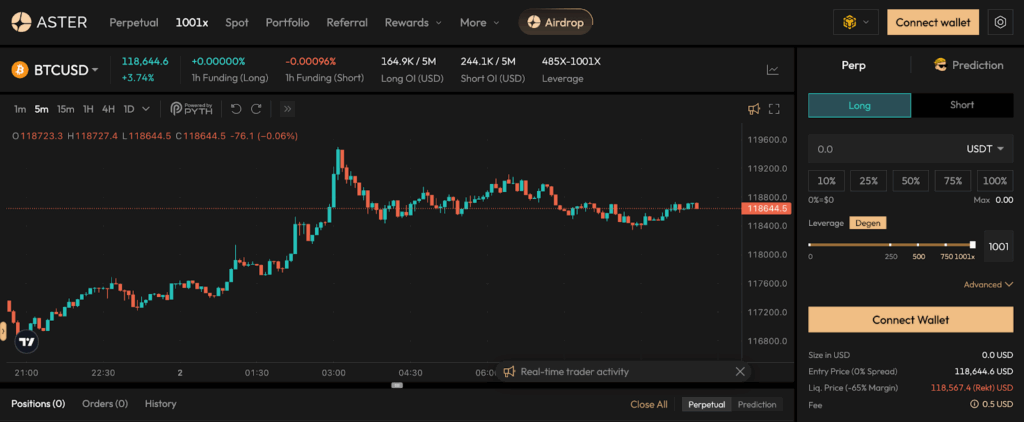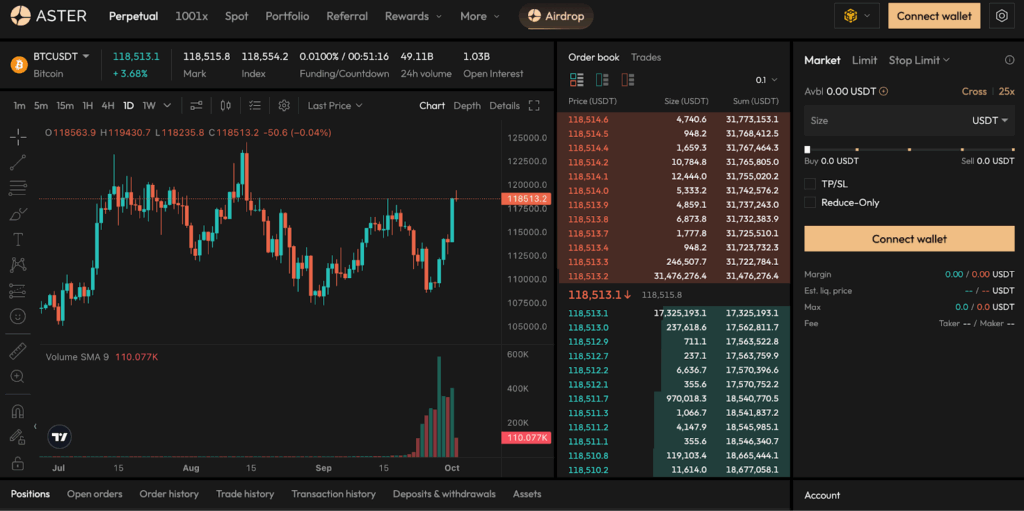Aster has quickly emerged as one of the most talked-about platforms in crypto trading. Built on a multi-chain framework and supported by leading figures in the crypto space, it presents a strong alternative to traditional decentralized exchanges (DEXs). With features like up to 1001x leverage, yield-generating collateral, and privacy-focused trading tools, Aster is capturing the attention of serious traders across the ecosystem.
Whether you’re new to perpetuals or an experienced user seeking more control, Aster offers a unique blend of performance, flexibility, and privacy that sets it apart from platforms like Hyperliquid.
Quick Summary
- Platform Type: Decentralized Exchange (DEX)
- Specialty: Perpetual futures and spot trading with privacy features
- Max Leverage: Up to 1001x on select pairs
- Chains Supported: BNB Chain, Ethereum, Solana, Arbitrum
- Token: ASTER (BEP-20), max supply 8 billion
- Collateral: Supports yield-bearing assets like asBNB and USDF
- Privacy Features: Hidden Orders, MEV-aware routing
- Modes: Simple (1001x) and Pro (Advanced)
- Backers: YZi Labs (Binance-affiliated)
- Stock Perpetuals: Apple, Tesla, Amazon, etc., available 24/7 in Pro mode
What Is Aster?
Aster is a next-generation decentralized exchange designed for trading perpetual futures and spot assets without intermediaries. It runs on top of several blockchains, including BNB Chain, Ethereum, Solana, and Arbitrum. The platform allows users to place trades directly from their own crypto wallets while retaining full custody of their assets.
Unlike traditional exchanges, Aster does not hold your funds. Instead, it uses smart contracts to execute trades in a non-custodial and transparent manner.
What Makes Aster Unique?
Aster separates itself from other platforms by combining extreme leverage, capital-efficient collateral, and privacy-enhancing features. Here’s what sets it apart:
Dual Trading Interfaces
- Simple Mode (1001x):
- One-click trading interface
- Leverage up to 1001x on supported pairs
- Required stop-loss and “max loss” preview for safer trading
- Simple Mode (1001x):

- Pro Mode:
- Advanced tools like grid orders, bracket orders, and trailing stops
- Hidden orders that are not visible in the public order book
- Access to stock perpetuals like Apple, Tesla, and Meta
- Pro Mode:
Multi-Chain Support
Users can trade assets across BNB Chain, Ethereum, Solana, and Arbitrum without switching platforms or wallets. The system handles cross-chain operations in the background.
Yield-Bearing Collateral
- asBNB:
Staked BNB token that continues to earn rewards while used as margin
- asBNB:
- USDF:
Yield-bearing stablecoin backed by USDT and deployed in low-risk, delta-neutral strategies
- USDF:
Hidden Orders & MEV-Aware Routing
These features help large traders avoid front-running and sandwich attacks by keeping trade details private until execution.
How Does Aster Work?
Aster operates as a hybrid platform with two trading environments:
- Simple (1001x): For fast, guided, high-leverage trading
- Pro: For experienced traders needing full control and advanced tools
When users place a trade, the order is routed through privacy-aware systems. Aster checks margin and risk before settling trades on-chain. The smart contracts handle everything from execution to liquidation, ensuring transparency and user control.
What Are Perpetual Futures?
Perpetual futures are contracts that let you bet on the price of an asset like Bitcoin or Apple stock without owning it. They differ from traditional futures because they don’t expire. Instead, they use funding payments to stay aligned with the spot price.
- Long Position: You profit if the price goes up
- Short Position: You profit if the price goes down
- Funding: Paid regularly between traders to balance long/short positions
Aster supports perpetuals on crypto assets and selected stocks, with real-time funding updates and detailed P&L tracking.
Aster Token (ASTER)
The ASTER token powers the Aster ecosystem. It is a BEP-20 token on the BNB Chain with a maximum supply of 8 billion.
Token Use Cases:
- Governance: Vote on protocol changes and upgrades
- Trading Discounts: Lower fees for holding ASTER
- Staking: Stake ASTER for rewards and protocol revenue
- Airdrops: Receive allocations from the community rewards pool
Token Allocation:
- 53.5% Airdrop
- 30% Ecosystem & Community
- 7% Treasury
- 5% Team
- 4.5% Liquidity & Listings
How Does Aster Compare to Hyperliquid?
| Feature | Aster | Hyperliquid |
| Max Leverage | Up to 1001x (Simple) | Up to 40x |
| Stock Perpetuals | Yes (Pro) | No |
| Hidden Orders | Yes (Pro) | No |
| Collateral | Yield-bearing (asBNB, USDF) | Standard (e.g., USDC) |
| Trading Modes | Simple and Pro | Unified Order Book |
| Supported Chains | 4 (BNB, ETH, SOL, ARB) | Own Layer-1 Chain |
| Fees | From 0.01% maker / 0.035% taker | Varies by volume tier |
Aster focuses on privacy, capital efficiency, and multi-asset support. Hyperliquid emphasizes speed and throughput on a custom Layer-1 chain.
What Are the Fees?
Aster’s fees are competitive and transparent.
Pro Mode:
- Maker: From 0.01%
- Taker: From 0.035%
- Stock Perps: 0.10% maker, 0.20% taker
Simple Mode (1001x):
- Similar structure but subject to block-level funding and execution spreads
Traders can reduce fees further by paying with ASTER or qualifying for VIP tiers.
Security & Risk Considerations
While Aster brings innovation, users should also be aware of key risks:
- High Leverage Danger: 1001x means tiny price moves can trigger liquidation
- Token Supply Centralization: Reports show that a few wallets may control most of the supply
- Platform Risk: Relies on smart contracts; bugs or exploits remain a threat
- Regulatory Uncertainty: High-leverage, decentralized perps face unclear legal futures
Aster is non-custodial, but caution is still necessary. Always trade within your risk limits and understand liquidation mechanics.
Future Roadmap
Aster plans to launch its own Layer-1 blockchain (Aster Chain) focused on performance and privacy. It will use zero-knowledge proofs (ZKPs) for private yet verifiable on-chain activity.
The chain is currently in internal testing. The team says it will preserve user privacy and offer even faster settlement. No exact launch date has been announced.
Upcoming Airdrops and Rewards
Aster allocated over half of its token supply to community rewards. The initial airdrop claim period runs until October 17, 2025, after which any unclaimed tokens will be returned to the community pool for future distribution.
Many users are already farming airdrop points by trading or staking assets. Given the platform’s growth and user engagement, more reward campaigns are likely in the future.
Who Is Aster For?
Ideal for:
- Active perpetual traders looking for leverage and control
- Users who want stock and crypto perps on one interface
- Traders who value private execution and yield-bearing margin
- Multi-chain users on BNB, Ethereum, Solana, or Arbitrum
Not Ideal for:
- Long-term holders who want cold storage only
- Complete beginners are uncomfortable with managing liquidation risks
- Anyone unwilling to accept smart contract or oracle risks
Aster’s Role in the Future of Decentralized Trading
Aster is a powerful platform reshaping the landscape of decentralized derivatives trading. It combines high leverage, advanced trading tools, and privacy-first features, all without requiring users to give up custody of their funds.
Its rise has been fast, but the real test will be sustaining usage beyond launch hype. As the platform matures and its Layer-1 goes live, Aster could become a central force in the future of decentralized finance.
For now, Aster offers a compelling experience for traders who want capital efficiency, cross-chain support, and serious control over their trades.



